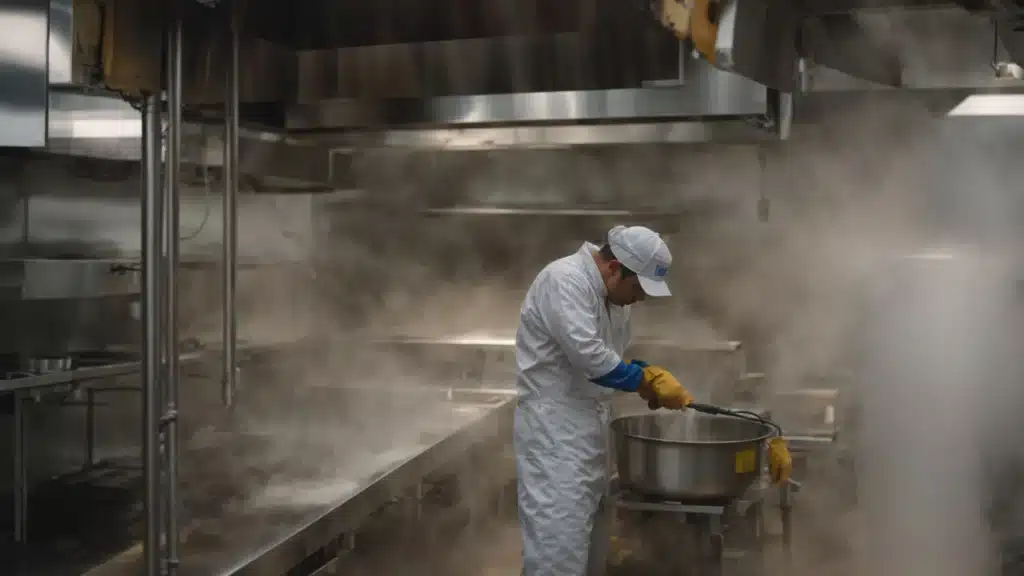Regular Hood and Kitchen Exhaust Cleaning
The Importance of Regular Hood and Kitchen Exhaust Cleaning
Within the heart of Ontario’s bustling kitchens, the hood and kitchen exhaust systems work silently, guarding against the potential havoc unchecked grease and dirt can wield.
Like sentinels standing guard over culinary creations, these systems play a crucial role in maintaining a clean, safe, and efficient cooking environment.
Yet, the importance of their regular cleaning and maintenance often goes unnoticed, a silent plea for attention amid the cacophony of a busy kitchen.
Recognizing the signs of wear and the dire need for professional care ensures these systems continue to protect both the people and meals within these spaces.
In this article, we uncover the layers of necessity surrounding regular hood and kitchen exhaust cleaning, stepping into a world where cleanliness equals culinary success.
Key Takeaways
- Regular Hood and Kitchen Exhaust Cleaning Minimizes Fire Hazards by Removing Grease Buildup
- Adherence to Cleaning Protocols Ensures Compliance With Health Regulations, Enhancing Public Safety and Trust
- Meticulous Cleaning Improves Kitchen Efficiency and Air Quality, Safeguarding Both Equipment Longevity and the Well-Being of Staff and Patrons
- Professional Inspections and Maintenance Are Crucial for Uncovering Hidden Issues and Ensuring System Integrity and Compliance
- Neglecting Exhaust System Cleanliness Leads to Increased Legal and Financial Risks, Including Potential Health Hazards and Regulatory Penalties
Why Regular Cleaning of Hood and Kitchen Exhaust Is Crucial
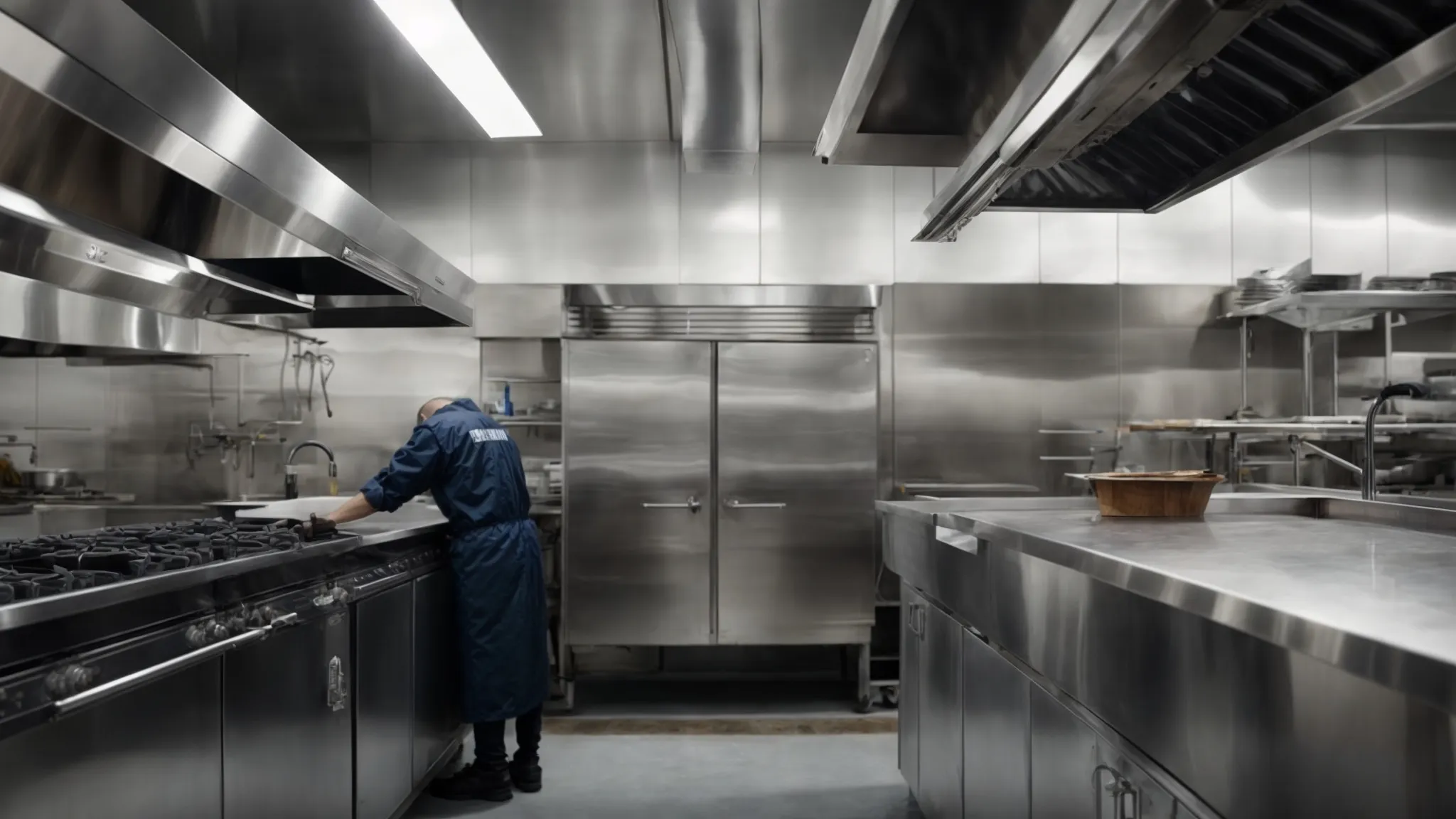
Embarking on a journey toward maintaining a pristine kitchen environment, it becomes evident that regular hood and kitchen exhaust cleaning vaults beyond mere aesthetics.
At its core, this meticulous practice serves as a fortress, safeguarding against the sinister dance of flames, thereby reducing fire hazards and crafting a safer haven for culinary endeavors.
Furthermore, it aligns establishments with health regulations, a noble adherence that shields both patrons and staff from unseen microbial adversaries.
This ritualistic cleaning not only amplifies kitchen efficiency and functionality, breathing life into every nook and cranny, but also caresses the soul of kitchen equipment, prolonging its lifespan and curbing the relentless tide of expenses.
In the realm where the air becomes a silent witness to the culinary ballet, improving its quality for those who inhale its essence becomes paramount, ensuring a chorus of well-being resonates throughout.
Moreover, this proactive approach acts as a sentinel against the spectre of penalties, securing business continuity amidst the ever-evolving tapestry of industry standards.
Reducing Fire Hazards for a Safer Environment
Within the bustling heart of any commercial kitchen, the menace of fire lurks, poised to disrupt the symphony of flavors with a mere spark gone astray. Regular cleaning of the hood and kitchen exhaust systems acts as a vigilant guardian, dramatically minimizing the risk of grease fires by removing the fuel that flames would fervently feast upon.
The meticulous removal of accumulated grease and debris not only forges a barrier against the tempest of fire but also enhances the overall efficacy of the fire suppression system nestled within the kitchen’s soul. In doing so, it ensures that should the unexpected arise, the defensive measures in place are primed to extinguish threats, preserving both lives and dreams woven into the fabric of culinary ventures.
Ensuring Compliance With Health Regulations
Adherence to health regulations is not merely a formality but the keystone in the arch of public safety and trust. By regularly cleaning hood and kitchen exhaust systems, restaurants and other commercial kitchens align their operations with stringent health standards, sidestepping the shadow of contamination that looms over unclean environments.
This dutiful observance acts as a beacon, signalling commitment to excellence and care for well-being. It ensures that establishments are not just places where meals are prepared, but sanctuaries where health and safety are as revered as the culinary arts themselves, thereby fortifying their reputation among patrons and inspectors alike.
Enhancing Kitchen Efficiency and Functionality
A kitchen, much like a beehive, thrives on the seamless flow of its myriad operations, and regular cleaning of hoods and kitchen exhausts is paramount in ensuring this harmony. Removing the accumulated grease and grime not only clears the path for unobstructed airflow but also optimizes the performance of kitchen equipment, allowing chefs to weave their culinary magic under the best conditions.
By diligently maintaining these systems, restaurants witness a significant reduction in energy consumption. Clean filters and ducts mean kitchen ventilation systems work less strenuously to eliminate heat and smoke, thus fostering a cooler environment. This efficiency translates into lower utility bills and a smaller carbon footprint, embodying the perfect symbiosis of economic and environmental stewardship.
Prolonging Equipment Lifespan and Reducing Costs
The journey of a kitchen’s heart, hood, and exhaust system, through regular cleansing, transcends mere operation, weaving into the fabric of longevity and fiscal prudence. Such diligent care strips away the relentless assault of grease and dirt, ensuring the guardians of culinary flames – from the humble oven to the mighty fryer – endure less wear and thrive under the banner of efficiency.
- The meticulous cleaning of hood and exhaust systems safeguards the kitchen’s vital organs against premature decline, ensuring every piece of equipment performs at its peak, unhindered by the burden of accumulated contaminants.
- Regular maintenance not only fortifies the kitchen against the gradual erosion of functionality but also acts as a bulwark against the tide of unforeseen expenses, laying a foundation of sustainability in both operations and economics.
- This ritual of rejuvenation empowers establishments to channel resources once destined for repair and replacement into innovation and growth, painting a future where culinary dreams flourish unencumbered by the spectre of operational inefficiencies and inflated costs.
In this beacon of stewardship, regular hood and kitchen exhaust cleaning become a talisman against the slow poison of neglect, nurturing the sinews and arteries of culinary domains with vigilance. The result? A vibrant kitchen ecosystem where each component, freed from the shackles of grime, collaborates in a symphony of productivity, paving the way for a landscape where cost savings blossom from the fertile ground of meticulous care.
Improving Air Quality for Staff and Customers
The tapestry of a kitchen’s atmosphere is woven not only with the aromas of culinary mastery but also with the quality of air that staff and patrons breathe. The diligent erasure of airborne grease particles and other contaminants through the regular hood and kitchen exhaust cleaning elevates indoor air quality, crafting an oasis where the only whispers in the air are those of gastronomic delight and convivial chatter.
Equally, this focused practice dissipates the invisible cloud of pollutants that may hover unnoticed, ensuring the kitchen’s breath is as pure as the dishes it produces. A commitment to this level of cleanliness is a commitment to the well-being of every soul entering the establishment, fostering an environment where culinary experiences are savored in the clearest of air.
Avoiding Penalties and Ensuring Business Continuity
Navigating the labyrinth of regulatory compliance is akin to walking a tightrope, where missteps in cleanliness can lead not only to severe financial penalties but also to the tarnishing of an establishment’s reputation. Regular hood and kitchen exhaust cleaning acts as a crucial balance pole, ensuring that commercial kitchens remain on the right side of the law and uphold a clean bill of health in the eyes of governing bodies.
Beyond the spectre of penalties, the continuity of a culinary business hinges on its ability to provide a safe and inviting ambiance for both employees and patrons. This essential cleaning service becomes the linchpin in preserving the uninterrupted flow of operations, forestalling shutdowns that could stem from safety inspections gone awry. It is this meticulous attention to detail that fortifies the resilience of a business, safeguarding its legacy against the caprices of unforeseen inspections.
Recognizing the importance of a pristine cooking haven is only the beginning. Let’s embark on a journey through the meticulous world of professional hood and exhaust cleaning.
Step-by-Step Guide to Professional Hood and Exhaust Cleaning
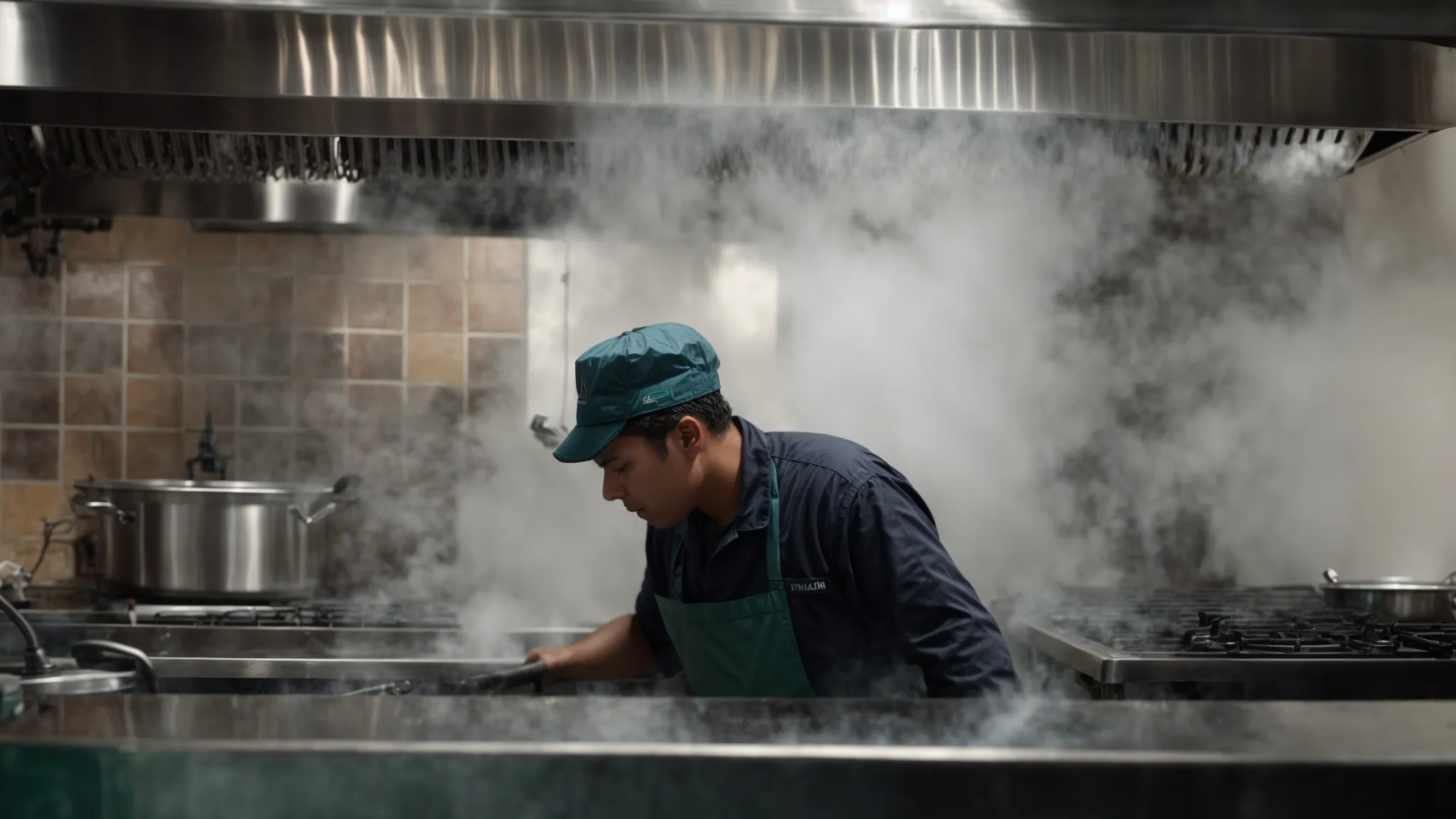
Nurturing the heart of culinary brilliance begins with the meticulous care of hood and kitchen exhausts.
This journey of upkeep unveils itself through an orchestrated series of steps, ensuring that every corner of the kitchen ventilation system breathes purity and safety.
Initiating with an initial inspection and assessment, professionals adeptly gauge the task at hand, crafting a blueprint for rejuvenation.
From there, the quest delves into the degreasing and cleaning hood filters, an act that strips away the vestiges of culinary battles past.
The mission continues with a thorough scrubbing and washing of the interior and exterior exhausts, dislodging grease and grime that cling like shadows.
Attention then shifts to the detailed cleaning of fans and ductwork, ensuring that the lungs of the kitchen inhale and exhale without hindrance.
Maintenance of exhaust fan hinges follows a critical check ensuring the framework’s integrity and functionality.
Culminating in a final inspection and functionality test, this comprehensive care package breathes life into the kitchen’s veins, setting the stage for culinary excellence and ensuring the safety and efficiency that comes from a well-maintained kitchen exhaust system.
Initial Inspection and Assessment
The journey of preserving a commercial kitchen’s heart begins with a meticulous initial inspection and assessment, where seasoned professionals examine the current state of the hood and exhaust system. This crucial first step lays the groundwork, identifying potential issues and areas that demand focused attention, and ensuring the subsequent cleaning process is tailored to meet the kitchen’s unique needs.
During this initial phase, experts employ a combination of keen observation and sophisticated diagnostic tools to create a comprehensive overview of the ventilation system’s health. The insights garnered here pinpoint the exact locations where grease accumulation poses the greatest risk, setting the stage for a targeted cleaning strategy that maximizes safety and efficiency.
Degreasing and Cleaning of Hood Filters
The process of degreasing and cleaning hood filters is akin to peeling back the layers of time from a precious artifact, revealing its original shimmer and functionality. Through the application of specific degreasers and meticulous brushing, professionals meticulously eradicate the buildup of grease—a byproduct of countless hours of cooking – that masks the filters. This step is critical, as clean filters directly influence the overall efficiency of the kitchen exhaust system, ensuring that it can perform its essential role of maintaining clean air and reducing fire risks.
Upon completion of the degreasing phase, the hood filters are then subjected to a thorough rinse, a baptism of sorts, where water acts as the purifying agent, washing away the remnants of grease and debris. This cleansing ritual not only restores the filter’s ability to function optimally but also significantly enhances the longevity of the kitchen’s ventilation system. Moreover, this process of rejuvenation supports compliance with health and safety standards, safeguarding the well-being of both the kitchen staff and patrons.
Scrubbing and Washing the Interior and Exterior Exhausts
The process of scrubbing and washing the interior and exterior exhausts is the cornerstone of a comprehensive kitchen exhaust cleaning regime. This thorough purification eliminates the layers of grease and particulate matter, ensuring that the exhaust system operates at peak efficiency and safety.
| Step | Action | Outcome |
|---|---|---|
| 1 | Scrubbing Interior Exhausts | Removal of Grease Build-Up |
| 2 | Washing Exterior Exhausts | Restoration of System Efficiency |
Executing these tasks with precision not only minimizes the risk of fires originating from grease accumulation but also reinforces the ventilation system’s contribution to a healthier kitchen environment. It’s a meticulous procedure that transforms a fire hazard into a beacon of cleanliness and safety, fortifying the kitchen’s defenses against threats seen and unseen.
Detailed Cleaning of Fans and Ductwork
The pathway to culinary excellence and safety weaves through the careful cleansing of fans and ductwork, a task of paramount importance in the ritual of kitchen upkeep. This intricate dance involves dislodging the stubborn layers of grease and soot that cling to these conduits of air, a process that ensures the kitchen’s breath remains pure and unobstructed.
Armed with specialized tools and a keen eye for detail, professionals embark on a meticulous journey to rejuvenate these critical components of the kitchen exhaust system. Their skilled hands navigate the labyrinthine passages of ducts, while centrifugal fans are liberated from the grime that hampers their efficiency, thereby bolstering the integrity of the entire ventilation network.
Inspection and Maintenance of Exhaust Fan Hinges
The meticulous inspection and maintenance of exhaust fan hinges represent a critical chapter in the saga of kitchen safety and functionality. These components, often overlooked, serve as the linchpins that ensure the hood and exhaust system pivot smoothly, facilitating essential airflow and preventing the accumulation of hazardous contaminants.
Professionals approach this task with the precision of a seasoned artisan, keenly inspecting the hinges for any signs of wear or damage that could impede their operation. Such vigilance guarantees that the exhaust fans remain operational, averting potential downtimes and promoting an environment where culinary creativity can flourish without concern for ventilation failures.
Final Inspection and Functionality Test
Upon the culmination of a thorough hood and kitchen exhaust cleaning process, the final inspection and functionality test stands as the pinnacle of quality assurance. This critical evaluation ensures that every cleaning milestone has been achieved with precision, and the ventilation system operates at its optimal capacity.
| Phase | Action Item | Outcome |
|---|---|---|
| Final Assessment | Conducting a meticulous inspection | Verification of cleanliness and operational efficiency |
| Functionality Test | Testing the ventilation system’s performance | Ensuring optimal airflow and safety standards are met |
This stage solidifies the integrity of the entire cleaning journey: from the initial inspection to the degreasing of critical components, culminating in a system that not only enhances the safety and hygiene of the kitchen environment but also upholds stringent health regulations. The marriage of meticulous cleaning with rigorous testing sketches a blueprint for culinary excellence, safeguarding the heart of the kitchen’s operations against the risks of fire and contamination.
Now, let’s shift gears, diving deep into the heart of your kitchen’s well-being. Spotting the cues that whisper “It’s time for a cleanse” in your exhaust system will be our next adventure.
Recognizing the Signs Your Kitchen Exhaust System Needs Cleaning
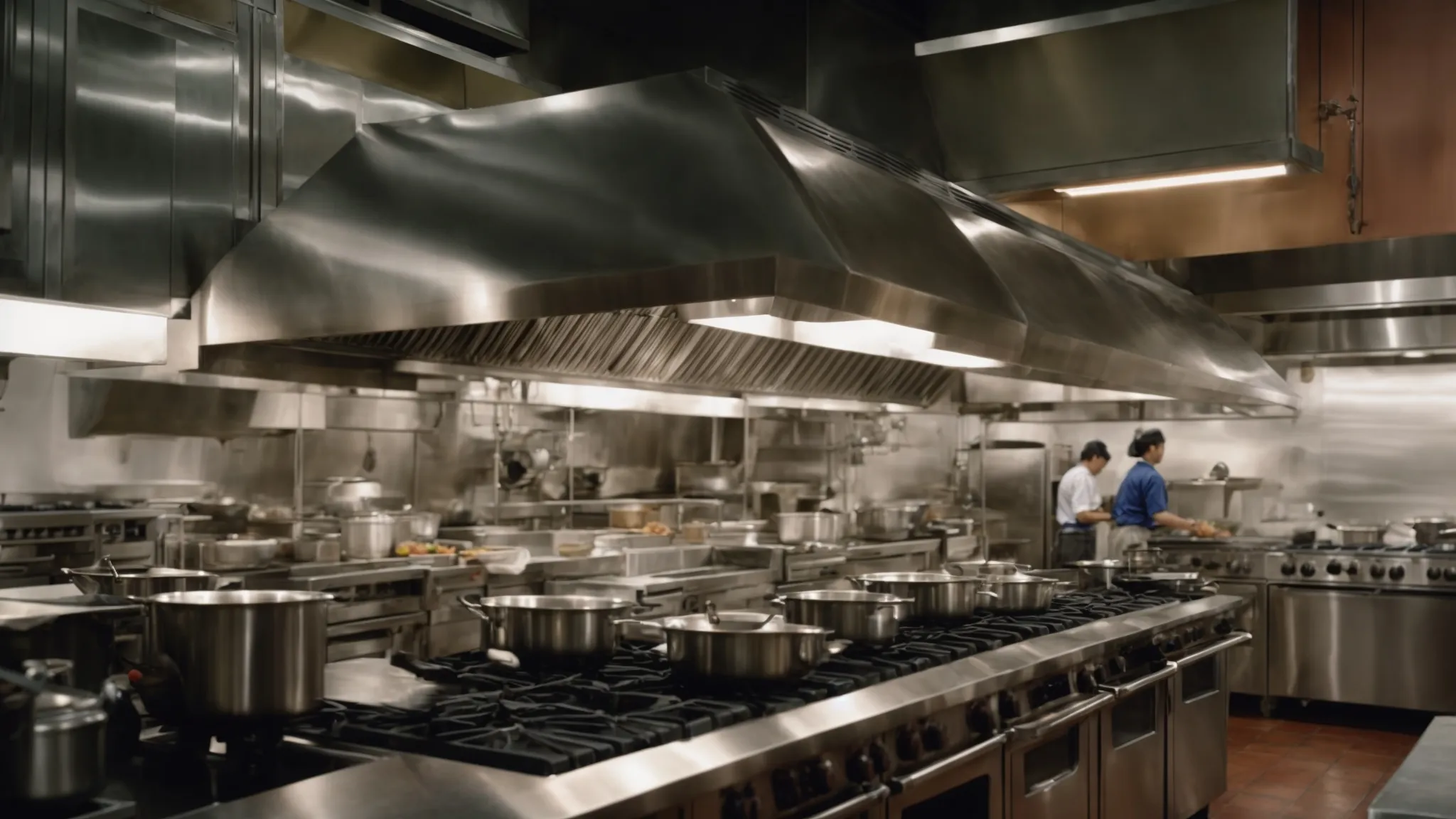
In the bustling theater of culinary excellence, the efficiency and safety of the kitchen exhaust system play starring roles in maintaining the balance between creativity and compliance.
Yet, its performance can wane, obscured by the very evidence of a kitchen’s industriousness.
Recognizing the signs that herald the need for cleaning becomes a critical mission, ensuring the culinary stage remains both vibrant and safe.
Visible grease buildup on hoods and filters casts a tangible shadow, signalling a breach in cleanliness that could fuel hazards.
A whisper of reduced airflow and efficiency tells tales of unseen struggles against constrictive grime, while unusual odors or smoke during operation speak volumes of compromised purity.
Moreover, an increased kitchen temperature subtly unveils the exhaust system’s plea for attention, each sign an actor in the unfolding drama of kitchen hygiene and safety.
Visible Grease Buildup on the Hood and Filters
The curtain rises on a common adversary within the culinary amphitheater: visible grease buildup on hoods and filters. This unwelcome guest, if left unaddressed, not only mars the sanctity of a clean kitchen but also escalates the risk of igniting fires, transforming a space of creative culinary expression into a potential hazard zone.
Professionals trained in the art of hood and kitchen exhaust cleaning possess the tools and expertise necessary to banish this greasy apparition. Their intervention reinstates the kitchen’s defenses against fire, ensuring that the heart of culinary operations beats with renewed vigor, free from the constraints of accumulated grease and the looming shadows it casts.
Reduced Airflow and Efficiency
In the intricate ballet of a bustling kitchen, the whisper of reduced airflow through the exhaust system serves as an early harbinger of inefficiency. This subtle yet significant shift signals an encroaching barrier against the swift escape of heat and smoke, a crucial element in maintaining an environment conducive to culinary artistry.
- Visible grease buildup on hoods and filters, an evident sign demanding immediate attention.
- A discernible reduction in airflow and efficiency, hinting at an obstructed kitchen exhaust system.
- The emergence of unusual odors or persistent smoke during operation, indicates potential contamination.
- An uptick in kitchen temperature, subtly unveiled the exhaust system’s struggle to ventilate effectively.
As airflow dwindles and efficiency falters, chefs find themselves battling against rising temperatures and lingering smoke, challenges that not only impede the culinary process but also threaten the health and comfort of kitchen staff and guests alike. Recognizing and addressing this decline is paramount, reinstating the kitchen’s breath and safeguarding the seamless orchestration of flavors and aromas.
Unusual Odors or Smoke During Operation
Unusual odors or smoke wafting through the kitchen during operation serve as undeniably stark heralds, signaling a compromised kitchen exhaust system. This ominous occurrence underscores an urgent need for a thorough examination and cleaning, as the integrity of the ventilation process is clearly being stifled by obstructions or contaminations within the hood and exhaust pathways.
Such phenomena not only disrupt the culinary rhythm by introducing unwelcome elements to the atmosphere but also raise red flags regarding the health and safety conditions in the kitchen. Addressing these signs promptly by engaging in professional hood and kitchen exhaust cleaning can restore the system’s functionality, ensuring a clean, efficient, and hazard-free environment for culinary creations to flourish.
Increased Kitchen Temperature
An uptick in kitchen temperature, often dismissed as a mere inconvenience, is a telltale sign of a kitchen exhaust system crying out for attention. This subtle yet critical increase serves as a silent alarm, indicating that the system’s ability to evacuate heat efficiently has been compromised, often due to buildup or blockages within the exhaust pathways.
Professionals versed in the nuances of hood and kitchen exhaust cleanliness understand the gravity of this symptom. They acknowledge that an elevated kitchen environment not only challenges the comfort and productivity of culinary staff but also hints at deeper, potentially hazardous issues lurking within the exhaust system’s inner workings.
With the mystery of your kitchen’s exhaust system’s signals unveiled the adventure unfolds into choosing the perfect guardians for your hood. The quest for cleanliness is about to take an exhilarating leap forward.
Selecting the Right Cleaning Service for Your Kitchen Hood System
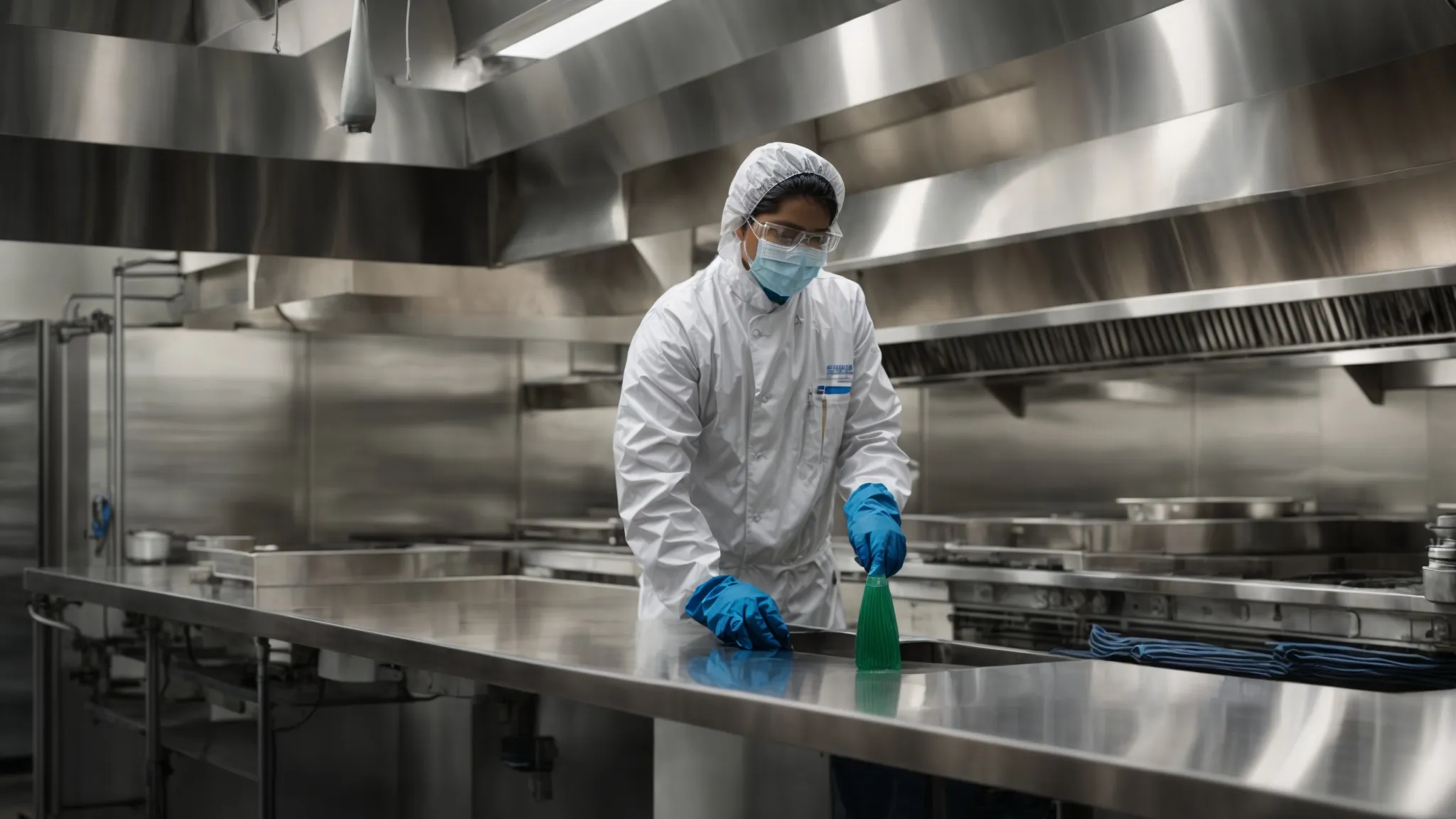
Navigating the labyrinth of hood and kitchen exhaust cleaning requires more than a cursory glance at the nearest provider; it demands a strategic approach to selecting a service that stands as the custodian of safety, efficiency, and compliance.
Embarking on this quest involves a series of critical evaluations – verifying certifications and industry experience to assure technical proficiency, reviewing service plans and cleaning methodologies to ensure a comprehensive approach, checking customer reviews and references to gauge satisfaction and trust, and comparing quotes while understanding service agreements to align financial and operational expectations.
This judicious selection process underpins the foundation for a partnership characterized by reliability, transparency, and unwavering dedication to kitchen hygiene and safety.
Verifying Certifications and Industry Experience
In the quest to uphold the sanctity of a commercial kitchen’s airways, venturing into the verification of certifications and industry experience emerges as a critical endeavor. Accreditation by reputable bodies such as the National Fire Protection Association or equivalent authorities offers a beacon of trustworthiness, ensuring the chosen cleaning service adheres to the gold standard of safety and efficiency.
Assessing the tapestry of industry experience unfurls an equally important narrative; a cleaning service’s longevity and track record in handling diverse kitchen environments speak volumes of its expertise and adaptability. Such an evaluation serves as the cornerstone in choosing a partner who not only promises but ensures a breathable, fire-safe, and compliant kitchen atmosphere:
- Accreditation by established safety and health standards authorities,
- A rich portfolio of services across various commercial kitchen settings,
- Endorsement from industry peers and long-standing clients.
Reviewing Service Plans and Cleaning Methodologies
Embarking on the selection of a cleaning service, one must meticulously examine the service plans and cleaning methodologies offered. This scrutiny ensures that the proposed approach aligns not only with the kitchen’s specific needs but also with the overarching goals of safety, efficiency, and regulatory compliance. An adept cleaning service distinguishes itself by tailoring its methods to address the unique challenges of each kitchen’s ventilation system, employing a blend of tried-and-true techniques and cutting-edge technologies.
A careful audit of cleaning methodologies reveals the depth of a service’s commitment to excellence. The techniques must utilize not only achieve a surface level of cleanliness but penetrate the depths of the hood and exhaust system, eradicating grease and contaminants at their source. This vigilance in selecting a service equipped with comprehensive cleaning solutions and a strategic plan lays the groundwork for maintaining a kitchen environment that is not only clean but truly sanctified against hazards.
Checking Customer Reviews and References
Delving into the hearts and minds of those who have previously journeyed with a kitchen Hood Cleaning service casts a revealing light on what one might expect. Perusing customer reviews and references becomes an essential step, serving as a window into the company’s reliability, effectiveness, and professionalism. These firsthand accounts build a narrative, helping potential clients paint a vivid picture of their possible future experiences.
References act as a hallmark of trust and precedent, offering assurance of the cleaning service’s ability to meet and exceed expectations. Engaging with past clients reveals the company’s track record in real-world scenarios, illuminating its responsiveness, attention to detail, and dedication to safety and cleanliness. This layer of transparency is invaluable, furnishing stakeholders with the confidence needed to forge a partnership.
Comparing Quotes and Understanding Service Agreements
In the final stages of securing a hood and kitchen exhaust cleaning service, comparing quotes becomes an essential pillar of decision-making. By evaluating different financial proposals, businesses position themselves to achieve a harmonious balance between quality service and budgetary considerations, ensuring that every dollar invested aligns with their expectations of safety, efficiency, and regulatory compliance.
Understanding service agreements, on the other hand, unfolds as a meticulous practice of safeguarding the future. It entails a thorough examination of the terms and conditions, service scope, frequency of cleaning, and any guarantees or liabilities covered. This process ensures a clear and mutual understanding between the service provider and the client, setting the stage for a partnership founded on transparency and trust.
Navigating the maze of professional cleaning options unlocks a new adventure: mastering your own kitchen’s destiny. Grab your tools, because we’re launching into the art of DIY maintenance for your hood and exhaust system.
DIY Tips for Maintaining Your Hood and Kitchen Exhaust Between Cleanings
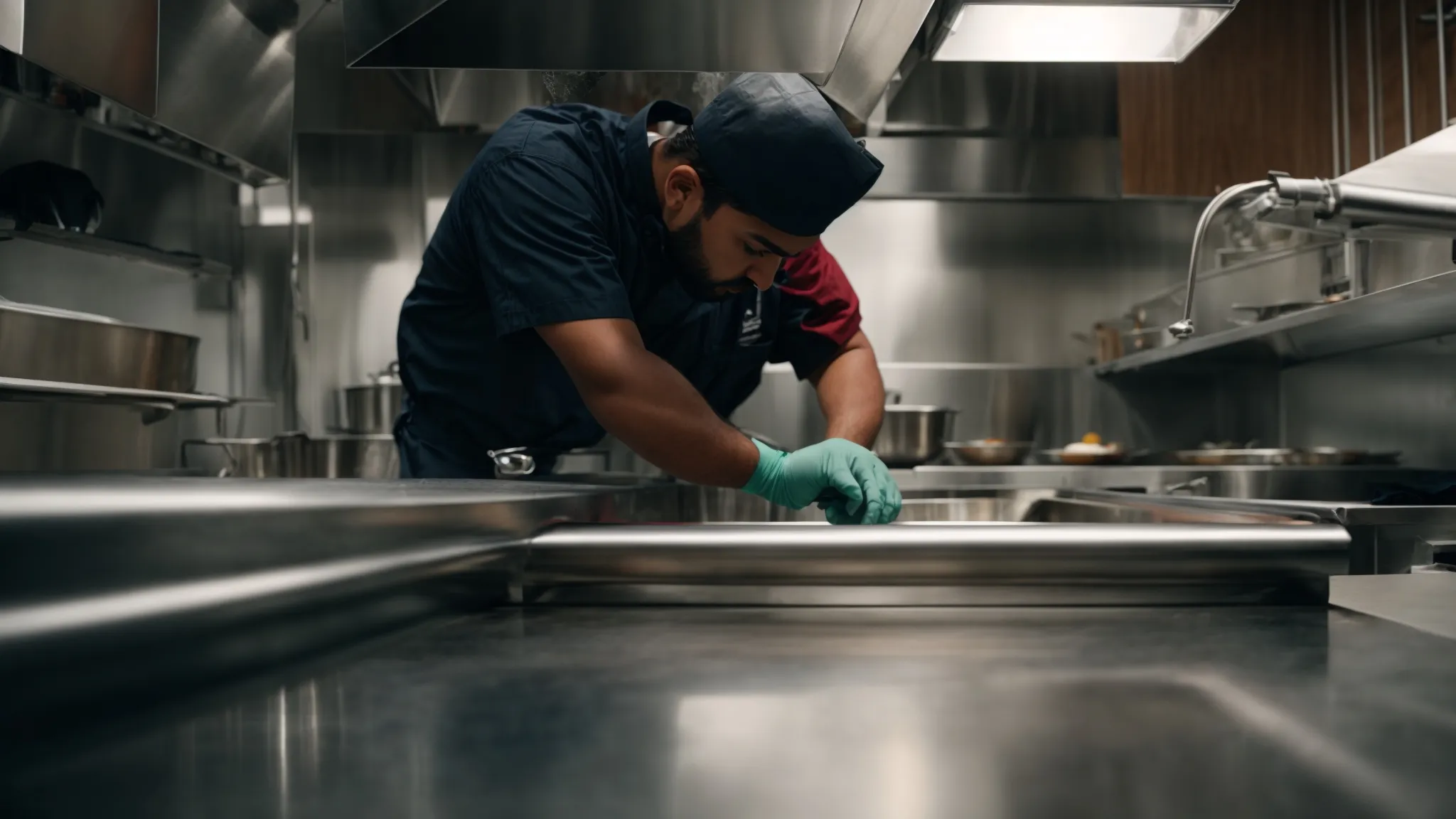
Maintaining the heart of your commercial kitchen requires dedication not only to the routine of professional cleaning services but also to the vigilant upkeep practices undertaken between those comprehensive cleans.
Embarking on this continuous journey involves a cascade of proactive measures designed to uphold the cleanliness and functionality of your kitchen’s ventilation system.
Regularly inspecting and cleaning filters, wiping down exterior surfaces to prevent the accumulation of grease and dust, diligently monitoring and cleaning grease traps, and scheduling professional inspections with a cadence that matches your kitchen’s demands form the cornerstone of effective exhaust and hood maintenance.
This commitment ensures a seamless bridge between professional deep cleansers, safeguarding the kitchen’s operational efficiency, air quality, and fire safety.
Regularly Inspect and Clean Filters
In the crusade against contamination and inefficiency, the ritual of inspecting and cleaning filters emerges as a cornerstone. As guardians standing watch over the purity of a kitchen’s atmosphere, these filters capture the detritus of culinary conquests, yet their efficacy fades under the burden of accumulated grease and debris.
Engaging in regular inspection and cleansing of these vital components breathes new life into the lungs of the kitchen, ensuring a relentless stream of clean air that supports both the vitality of the environment and the well-being of those within it. This act, simple yet impactful, fortifies the kitchen’s defenses against the insidious creep of pollutants, maintaining a bastion of cleanliness and efficiency until the next professional overhaul.
Wipe Down the Exterior Surfaces
Embracing the simplicity and necessity of cleanliness, regular wiping down of the exterior surfaces of hoods and exhausts stands as a critical preventative measure. This straightforward, yet effective procedure ensures that the accumulation of grease and dust is kept at bay, maintaining the kitchen’s aesthetic appeal and hygiene standards.
Furthermore, by establishing a routine of wiping down these critical areas, establishments can significantly reduce the risk of fire hazards associated with grease buildup. A clean exterior not only reflects well on the establishment’s commitment to cleanliness but also contributes to the overall safety and efficiency of the kitchen’s operations:
- Maintaining the kitchen’s aesthetic appeal through regular cleaning.
- Reducing fire hazards by preventing grease accumulation.
- Reflecting the establishment’s dedication to high standards of cleanliness and safety.
Monitor and Clean Grease Traps
In the labyrinth of kitchen maintenance, monitoring, and cleaning grease traps stand as a critical defense. This routine not only curtails the risk of blockages within the plumbing but also significantly reduces the possibility of unpleasant odors permeating the air, safeguarding the kitchen’s sanitary conditions and operational flow.
Cleaning grease traps, a task often overlooked plays a pivotal role in maintaining the kitchen’s environmental integrity. By routinely purging these receptacles of accumulated fats, oils, and grease, establishments shield their premises from the perils of backups and ensure compliance with health regulations, preserving the kitchen’s heartbeat.
Schedule Professional Inspections Regularly
Even with meticulous daily routines, the complexity of hood and kitchen exhaust systems demands expert eyes that only professional inspections can provide. These inspections delve into areas often overlooked, ensuring every component functions as intended and complies with stringent safety and health standards.
Inscribing professional inspections into the calendar of kitchen maintenance embroiders a tapestry of preemptive care: It underlines the commitment to upholding the highest standards of cleanliness and operational efficiency. Regular professional assessments demystify the condition of exhaust systems, bridging the gap between daily upkeep and the comprehensive care only specialists can offer.
- Regularly inspect and clean filters to maintain air purity and system efficiency.
- Wipe down exterior surfaces to keep grease and dust accumulation at bay, reducing fire hazards.
- Monitor and clean grease traps to avert blockages and unpleasant odors, ensuring a healthy kitchen environment.
- Schedule professional inspections regularly to uncover and address hidden issues, fortifying kitchen safety and compliance.
Armed with DIY strategies, your kitchen hood awaits its next challenge. Yet, the shadow of neglect looms large, teasing the untold tales of kitchen exhaust systems left forgotten.
Understanding the Impact of Neglected Kitchen Exhaust Systems
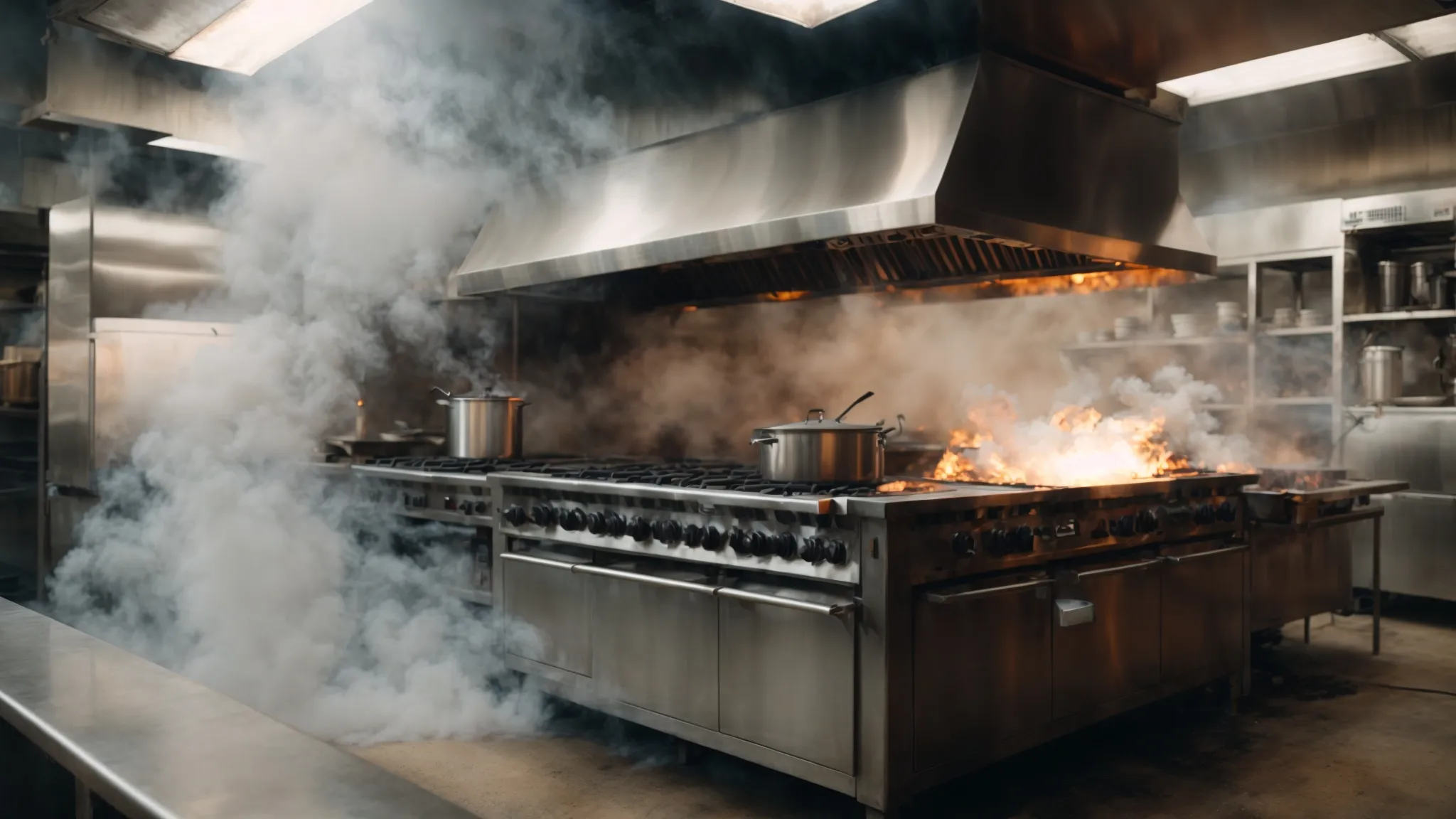
Beyond the immediate annoyance of smoke and grease, a neglected kitchen exhaust system poses a number of risks that have the potential to fundamentally alter the course of any culinary endeavor.
Delving into case studies reveals that kitchen fires, often ignited by the buildup of unattended grease, serve as grim reminders of the paramount importance of regular cleaning.
The tale does not end with the quenching of flames – the long-term consequences ripple through the machinery of the kitchen, where the efficiency of equipment nosedives, heralding elevated repair costs, and a shortened lifespan for vital tools of the trade.
Beyond the tangible damage, the specter of health risks looms, as poor air quality and inadequate ventilation become breeding grounds for bacterial contamination and respiratory complaints among staff and patrons.
The narrative is further complicated by the legal and financial shackles imposed on business owners found in violation of health and safety standards, casting a long shadow over the fiscal health and reputation of establishments.
It is within this context that the urgency for meticulous hood and kitchen exhaust maintenance gains its full stature, highlighting a path not just towards compliance, but towards safeguarding the heart of culinary operations.
Case Studies of Kitchen Fires Linked to Inadequate Cleaning
Intriguing yet cautionary tales emerge from kitchens across the globe, painting a vivid portrait of the grave repercussions born from disregarding the cleanliness of hood and kitchen exhaust systems. One such case involved a renowned dining establishment where grease accumulation sparked a fire that ravaged the kitchen, leading to extensive property damage and operational downtime:
- A buildup of uncleaned grease in the exhaust system acted as the primary fuel for the fire.
- The intensity of the grease fire overwhelmed the fire suppression system, which took too long to put out the flames.
- Resulting damages extended beyond repair costs, including lost revenue from weeks of forced closure.
Another documented incident underscores the risks to human health and safety, where a small, unnoticed fire smouldered within a clogged exhaust duct, eventually breaking out into the dining area. This event not only led to emergency evacuations but also highlighted significant lapses in routine maintenance and safety protocols, casting a shadow over the establishment’s reputation and compelling a reevaluation of their cleaning schedules:
Long-Term Effects on Equipment Efficiency and Repair Costs
Neglected kitchen exhaust systems become a harbinger of inefficiency for culinary equipment, throttling their ability to perform with the finesse required in the high-stakes theatre of cooking. The grim accumulation of grease and contaminants insidiously wears down the machinery, leading to an increased demand for energy resources and a noticeable drop in operational effectiveness.
This insidious decline manifests not just in diminished performance but also in stark, quantifiable financial burdens related to repair and replacement costs. Establishments find themselves ensnared in a cycle of reactive maintenance, where the price of neglect far exceeds the cost of prevention, eroding the foundation of economic sustainability in an environment where every penny counts.
Health Risks Associated With Poor Air Quality and Ventilation
The air that shrouds a kitchen, marred by neglected exhaust systems, morphs into an invisible adversary, suffusing the environment with contaminants and poor-quality ventilation. This degradation of indoor air not only tarnishes the sanctity of culinary spaces but also sows the seeds for respiratory ailments among the staff and patrons, a silent epidemic brewing in the heart of bustling kitchens.
In environments where air no longer whispers but groans under the weight of grease and unwelcome particulates, the risk of bacterial growth skyrockets, further compromising the health of those breathing within. Kitchens, unintentionally transformed into Petri dishes, become the unsuspecting hosts to a myriad of health concerns, underlining the imperative for rigorous and regular hood and kitchen exhaust cleaning.
Legal and Financial Repercussions for Business Owners
Business owners who neglect regular hood and kitchen exhaust cleaning face legal and financial repercussions that extend beyond immediate repair costs. Regulatory bodies can levy hefty fines on establishments failing to comply with safety and health standards, a burden that may strain the fiscal health of a business significantly.
In addition to regulatory penalties, the negligence of exhaust system cleanliness can lead to increased insurance premiums or, in severe cases, denial of coverage. This situation places owners in a precarious financial position, risking their ability to recover losses in the event of a fire or other related incidents.

